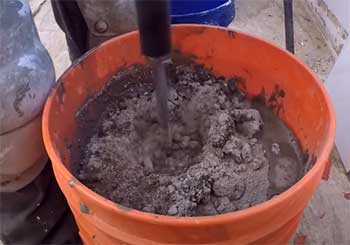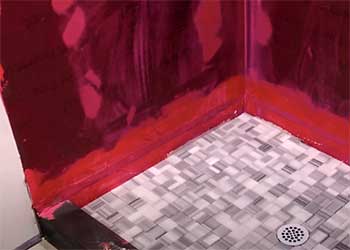Shower pans can either be a life-saver for your bathroom or cost you another week of bathroom remodeling. But how, you might ask: due to mold, poor ventilation, water damage of a shower pan, among many others.
Whenever people look for DIY shower pans, they go for mortar or tile-redi shower pans.
This article is about Tile Redi shower pan vs. mortar comparison and talks about its features so that it eases the process for you to choose between.
A Brief Comparison Table
Let’s make this easier: here’s a side-by-side comparison table for you to review. Specification Tile Redi Shower Pan Mortar Material Polyvinyl Chloride, ABS (acrylonitrile-butadiene-styrene) Portland Cement combined with sand (graded, commercial, concrete and fine) Quality Superior Inferior Weight Lightweight Heavyweight Texture Smooth Rough Pricing Expensive Cost-Effective Availability Not Always Whenever
Primary Differences Between Tile Redi Shower Pan And Mortar

Understanding which primary differences make each product stand out on its own is essential.
By figuring out the components of each product, we’ll be able to decide which product is the best for us. In this section, we’ll learn all about the materials used, the build quality, weight, pricing, etc.
- Building Materials
The building materials, or ingredients, can define the different factors of a product. What’s more, is that these building blocks determine the overall quality.
These very ingredients bring out long-lasting products. Not only do they fulfill their primary purpose to provide excellent service, but they’re also here to serve for the decades to come.
Mortar is a mixture of Portland cement combined with either graded, commercial, concrete, or fine sand.
They’re known for being durable and flexible. However, it does have some disadvantages.
Cracks in the mud shower bed can easily hold in moisture, which can later be harmful to the structure itself. When that happens, the mud will be soaked from the floor of the pan.
But, if you’re unsure whether your mud is taking in moisture, then looking for dampness may help.
When it comes to tile-redi shower pans, they’re are made from polystyrene combined with other stable materials such as fiberglass. As they can be easily be molded, such as cutting down or building up, they are customizable to fit your shower base.
The fiberglass in the product makes it harder for water to seep through and leak moisture inside.
Doesn’t this make it a better choice by default? To me, it seems like so! Not only is this a better choice, but it also shows that the tile-redi shower pans are much more durable and stronger in comparison.
In summary, it is safe to trust tile-redi shower pans for your bathroom shower base.
- Design & Product Quality

Both shower pans come in different sizes. However, tile-redi shower pans aren’t customizable like the mortar-made ones.
As mortar is laid down by hand, you have more flexibility in customizing shapes and sizes. In contrast, tile-redi shower pans are ready-made for you by machine with no control over the dimensions other than the standard ones.
At the end of the day, it’s your choice to make!
We have already established why tile-redi shower pans are the best for the job when it comes to quality. They provide better moisture protection and a much easier installation and maintenance process.
- Weight
Weight 一 another vital factor to consider before purchasing either shower pans.
As you have to mix it with cement and sand, mortar is much heavier than the tile-redi shower pan. And, the heavier a product is, the harder it is to work with them.
Why work with something heavier when you can make the installation process much easier?
Another bright side to look at is this: as the tile-redi shower pan doesn’t require any professional skills, it’s also the easiest to fix or change.
Mortar-made shower pans are tougher to deal with as they’re settled and sealed permanently into place. This makes tile-redi shower beds the easiest shower beds to install.
Let’s move on to the expense bit of the comparison.
- Pricing
Investing in the construction within a specific part of your home is no joke, which is why budgeting is an essential factor to consider.
Have you heard the phrase, “All that glitters is not gold”? Well, while that’s undoubtedly true, there’s also a reason why some materials are cheaper.
When you hire a professional tiling service for poured mud shower pan installation services, you can expect costs to be somewhere between $350 to $650.
That, too, depends on the type of materials you want to use. For example, plastic, acrylic, and fiberglass might be more cost-effective, but they lack longevity.
On the other hand, tile-redi shower pans start from $600. But, many homeowners have claimed to be satisfied with how long they can last over the years.
Tile-redi shower pans are definitely costlier than mortar-made shower pans.
Is Tile Redi Shower Pan Waterproof or Mortar?

Whether your shower bed has waterproofing is another crucial factor to consider.
As we’re looking for the best shower bed, we need one that will not leak water inside and cause moisture.
Although poured mortar shower beds are very secure, we cannot say for sure that they won’t ever cause water to leak.
The product needs to use a waterproof membrane, meaning it needs to have a moisture barrier sealed in place. The moisture barrier will keep the base from getting damp.
Mortar shower beds require professional skills to get the installation right. One wrong step can cause you more expenses than you initially intended to spend.
Tile-redi shower beds are best suited when it comes to waterproof shower beds. However, as they come directly manufactured from the company, there may be defects, so always ensure that you check the product before you use it.
My Choice Between The Two!

Now that we’ve reviewed the characteristics of both the shower beds, we can finally conclude and decide which one is best suited for you. Both methods have several factors to be considered.
But, you can only go ahead with one.
We’ve already seen how waterproofing works for both products, making it up to us to judge the rest of the features.
Even though mortar is cost-effective, there are still risks involved. On top of that, you need to hire a professional to do the job, which can be costly and time-consuming.
Tile-redi showers beds, in comparison, have a smoother texture are easier to install, albeit quite expensive. Thus, making it the winner of this comparison.
Then again, if you’re looking for a cement-based shower bed that will go well with your shower base, then the mortar is the one you should go for.
Conclusion
We’re finally at the end of the Tile Redi shower pan and mortar comparison! Hopefully, you have found the choice of your shower bed, which will protect your shower against mold or mildew.
We are happy that this article has helped you make an important decision. Even if we were not much help, do keep in mind that these two were some of the many options available.
There are many other mixtures and brands available that we haven’t discussed.
If none of the comparisons helped you decide, we highly recommend doing extensive research on the other available options. Best of luck!
